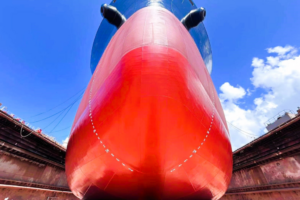As part of its sustainability endeavors, German container shipping line Hapag-Lloyd has revealed that it cut down on harmful emissions by implementing Shipshave’s In Transit Cleaning of Hull (ITCH) solution which
As part of its sustainability endeavors, German container shipping line Hapag-Lloyd has revealed that it cut down on harmful emissions by implementing Shipshave’s In Transit Cleaning of Hull (ITCH) solution which was documented and confirmed by Norway’s classification society DNV.

As disclosed, in order to verify the benefits of ‘proactive’ fouling removal, Shipshave and Hapag-Lloyd commissioned DNV to analyze the operational performance data from two Hapag-Lloyd boxships outfitted with ITCH.
The vessels in question are said to be 8,749 TEU and 18,800 TEU boxships, respectively, of different ages and different trading profiles.
The recent analysis included data harvested from both vessels over a 17-month period, allowing for an “in-depth” consideration of ‘trend over time’ to study whether Hapag-Lloyd’s approach to hull cleaning delivered “representative and consistent results.”
During this assessment period, the ITCH system reportedly managed hull biofouling “with success” by initially reducing resistance. As explained, additional fouling would build up over time without repeated hull cleaning. Moreover, one of the conclusions was that proactive grooming could potentially prevent future degradation of vessel performance due to fouling re-growth.
According to Shipshave, this long-term effect was not accounted for in the analysis because of which it is likely to underestimate the total economic benefit of cleaning with ITCH. Nonetheless, the return on investment (ROI) for the two vessels is believed to have been under 3 months at sea.
In a report following the assessment, DNV is said to have confirmed that both ships achieved ‘significant’ fuel savings and reduction in emissions based on ‘improved’ energy efficiency. What is more, as per the Norwegian class society, the actual reduction in fuel and emissions varied between the vessels due to their different dimensions but were both ‘satisfactory’.
Specifically, one boxship saw an improvement of 16% in performance, which is equal to a reduction in fuel consumption of approximately 8.4 tons per day, DNV highlighted. The second unit, however, showed ‘better initial performance’ but achieved a reduction of just under 5%. As DNV stated, the performance itself was maintained by regularly using the ITCH solution.
“We are very pleased that this analysis from DNV confirms our internal assessment of the result achieved by the implementation of ITCH. This method reflects our proactive approach to reducing emissions caused by biofouling,”Nikhilesh Bhatia, Director of Fleet Energy Efficiency, who is responsible for the ITCH project at Hapag-Lloyd, shared.
Shedding further light on the matter, Uwe Hollenbach, Senior Principal Consultant at DNV Maritime Advisory, Ship Performance Center in Hamburg, remarked, “The findings of this case study emphasize the critical role of minimizing biofouling in reducing greenhouse gas emissions from shipping. As outlined in our recent Maritime Forecast to 2050 report, regular or proactive hull cleaning remains one of the most effective strategies to achieve this goal.”
Shipshave’s ITCH solution was introduced back in 2020 as the industry’s ‘first’ hull cleaning system for commercial vessels in transit. At that time, the company’s representatives explained that this solution was meant to address fouling ‘head on’, i.e. before it became a real problem. That said, Shipshave then underscored that the solution could also be applied to remove settled fouling via repetitive operations.
The semi-autonomous hull cleaning robot comprises a winch on the foredeck of the vessel that tethers the robot. The robot is said to be fitted with soft brushes, allowing it to harvest propulsion energy to clean the vertical sides of the hull underwater and sweep up and down. It travels with a defined pattern with controlled brush forces, the company elaborated.
Upon its introduction, ITCH gained attention from industry players seeking to cement their decarbonization ambitions. In April 2023, Hamilton-based tanker shipping company Teekay Tankers announced that it had plans to install ITCH on four vessels as part of its ‘energy efficiency’ strategy aimed at achieving the company’s greenhouse gas (GHG) emissions reductions.
More recently, within the broader space of biofouling solutions, the UK-based classification society Lloyd’s Register (LR) granted the maritime industry’s ‘first’ enhanced antifouling type approval to Canada’s coatings company Graphite Innovation & Technologies (GIT Coatings).
As informed, GIT Coatings was awarded the approval for its XGIT-Fuel graphene-based hull coating, designed to create an ultra-low friction surface, believed to increase vessel performance and minimize emissions without the use of biocides, silicon oils, or other toxic components.
Related Article
-
 Posted: about 1 month ago
Posted: about 1 month agoLR awards”first-ever” enhanced antifouling type approval
Categories:- Certification & Classification
Posted: about 1 month ago
Content Original Link:
" target="_blank">

























































